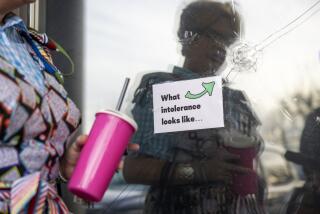Boycott? More like bullying
MONDAY’S “Great American Boycott,” which was timed to coincide with the traditional May Day communist celebration of the worker, has been compared to the nonviolent 1965 march for voting rights from Selma to Montgomery, Ala. Organizers even passed out copies of “We Shall Overcome” in Spanish.
Don’t buy it.
The Selma-to-Montgomery march was about voting rights afforded to citizens under the Constitution; the May Day boycott was a demand for entitlements grounded only in the imaginations of the organizers. What happened at the Edmund Pettus Bridge outside Selma was a nonviolent demonstration to build sympathetic political support for legislation to guarantee long-delayed voting rights; this was a boycott whose explicit purpose was to inflict economic pain. The fact that it did not succeed doesn’t change that.
Monday’s rallies also had little in common with the peaceful protests in L.A. and other cities in late March and early April. Those were homegrown, “organic” demonstrations that sprang up, without much formal organization, in response to onerous provisions in a House-passed immigration bill. They had their genesis in Spanish-language radio, the Internet, even text messaging among teenagers and young adults.
Monday’s demonstration at Los Angeles City Hall, on the other hand, was a creation of the radical left, a wholly owned subsidiary of umbrella groups such as ANSWER (Act Now to Stop War and End Racism), union organizers and fierce political partisans acting on agendas of their own.
Even though a starry-eyed Los Angeles Times editorial called the march “peaceful and mostly joyous,” the fact remains that its purpose was fundamentally malevolent. In Los Angeles, a spokesman for the International Longshore and Warehouse Union spoke hopefully of “total chaos at the ports.” In the process, organizers risked setting back legitimate efforts at immigration reform by years.
Individuals and mainstream organizations that have fought years for immigration reform wisely stood down. The National Capital Immigration Coalition refused to endorse the boycott. In L.A., Cardinal Roger Mahony lobbied against it. “Go to work, go to school, and then join thousands of us at a major rally afterward,” he implored.
Beyond economic chaos, what did the organizers want? Not just defeat of the restrictive House immigration bill. “We want full amnesty, full legalization for anybody who is here” illegally, said Jorge Rodriguez, a union official who helped organize the protests.
While such calls may energize the organizers’ radical base, Americans don’t respond well to bullying, a sense of entitlement or “in your face” tactics, and the ultimate result of all this will be a hardening of positions.
Already, the founder of the Minutemen border control group has been quoted as saying that “it’s intimidation when a million people march down Main streets in our major cities under the Mexican flag.”
And it’s not just xenophobic and anti-immigrant Anglos who will be alienated by a radicalized boycott. Latinos, too, will be turned off.
By radicalizing the immigration issue, the organizers of Monday’s boycott polarized an already emotional issue further, and in so doing risk reversing their own goals, if not permanently then at least significantly, and for a long time.
The May Day boycott wasn’t Selma. It was a lot closer to Watts.
More to Read
Start your day right
Sign up for Essential California for news, features and recommendations from the L.A. Times and beyond in your inbox six days a week.
You may occasionally receive promotional content from the Los Angeles Times.






